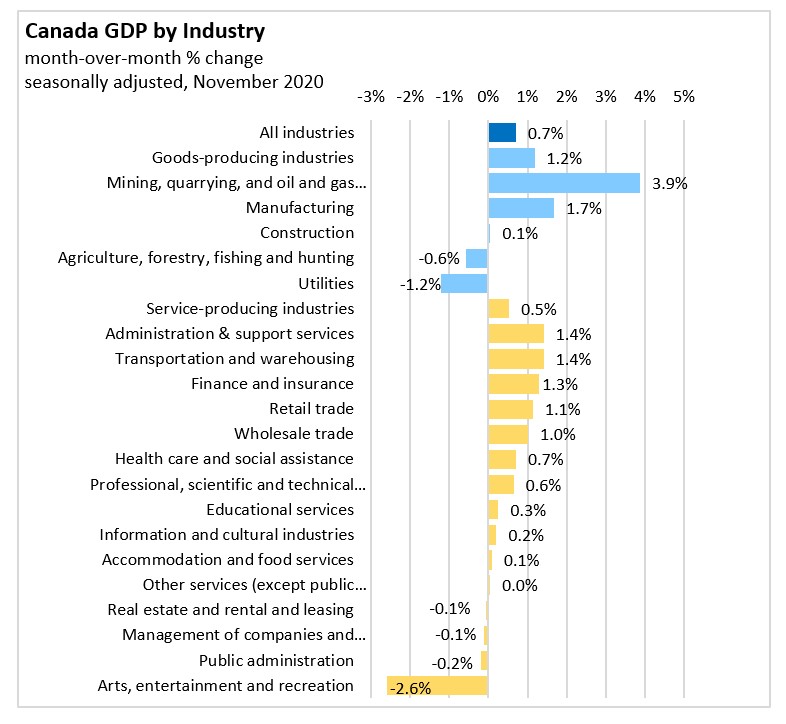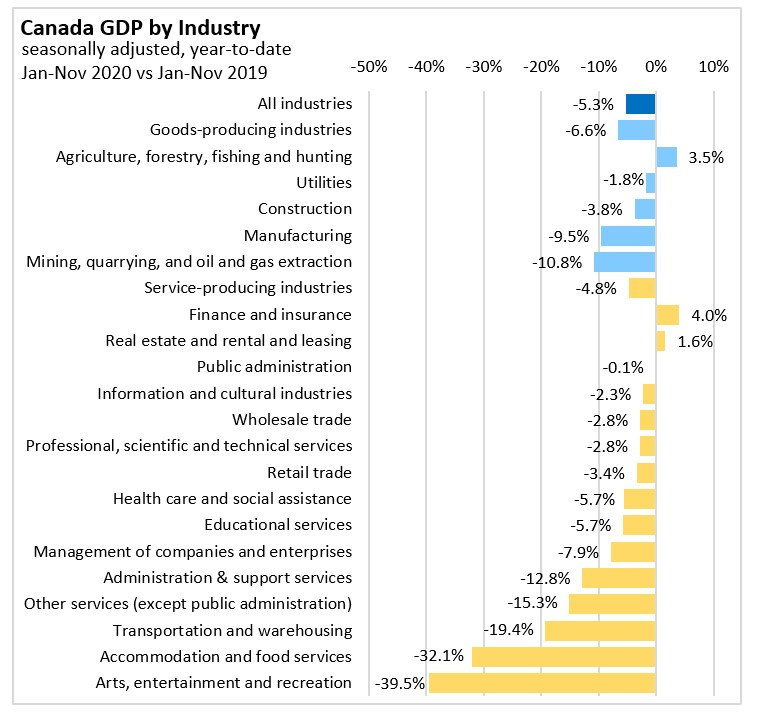The Economics and Statistics Division maintains archives of previous publications for accountability purposes, but makes no updates to keep these documents current with the latest data revisions from Statistics Canada. As a result, information in older documents may not be accurate. Please exercise caution when referring to older documents. For the latest information and historical data, please contact the individual listed to the right.
<--- Return to Archive
For additional information relating to this article, please contact:
January 29, 2021CANADA GDP BY INDUSTRY, NOVEMBER 2020 Real Gross Domestic Product (GDP) in Canada increased 0.7% in November following a 0.4% increase the previous month. This was the seventh consecutive month real GDP gain in Canada. While the gains over the last seven months offset some of the losses observed in March and April 2020, total economic activity was about 3.0% below the pre-pandemic level observed in February.
In November 2020, the Canadian economy is 2.8% smaller compared to November 2019 with an annualize value of $1,935 billion (chained 2012 dollars).
Statistics Canada’s preliminary estimate for real GDP points to an approximate 0.3% increase in December 2020. This flash estimate points to 1.9% increase in real GDP in Q4 2020 and a decline of 5.1% for 2020. The official GDP data for December and the fourth quarter will be published on March 2, 2021.


Goods-Producing Industries
Goods-producing sector output increased 1.2% month-over-month in November 2020. Output in all sub-sectors except utilises and agriculture, forestry, fishing, and hunting activity were up in November.
The mining, quarrying, and oil and gas extraction sector grew 3.9% in November with all three sub-sectors posting an increase in their activity. With higher international demand, all types of mining and quarrying activities increased in November resulting in 6.1% growth in the mining and quarrying sector’s output.
Oil and gas extraction activity was up 1.7% in November posting the third consecutive monthly gain. Due to higher synthetic oil production in Alberta, oil sands extraction increased 5.3%.
The manufacturing sector output increased 1.7% in November following a 0.5% contraction in the previous month. November’s gain was primarily a result of higher inventory formation and brought the sector’s output level to within 3.0% of its pre-pandemic level of activity.
Durable manufacturing output increased 2.0% in November. The growth was led by fabricated metal products (+7.1%), machinery manufacturing (+3.8%) and non-metallic mineral product manufacturing (+5.6%). Transportation equipment declined 1.3% in November for the second consecutive month. Non-durable manufacturing output increased 1.3%, led by plastics and rubber products (+4.1%), petroleum and coal product (+3.0%), paper (+3.0) and beverage and tobacco (+2.7%) manufacturing.
Construction GDP increased 0.1% in November. The gains in engineering and other construction activities (+0.6%) and repair activities (+0.1%) were offset by the decline in non-residential construction (-0.9%). Residential construction remained flat in November.
Utilities sector’s output declined 1.2% in November. Statistics Canada noted that milder weather across many parts of the country reduced demand for electricity for heating purposes.
Services-Producing Industries
Output of services-producing sector increased 0.5% in November 2020.
Activity in finance and insurance sector increased 1.3% in November with growth seen across all subsectors. Statistics Canada noted that news of multiple global COVID-19 vaccine increased activity on the Toronto Stock Exchange in November. Financial investment services, funds and other financial vehicles was up 3.5%.
Activity at the offices of real estate agents and brokers declined 2.6% in November, following a 1.9% decline in October. Housing resale activity decreased in the majority of Canadian urban centres, with Greater Toronto, Greater Vancouver, Montréal, Ottawa, Edmonton and Calgary contributing the most to the decline.
Retail trade sector’s output increased 1.1% in November with food and beverage (+6.1%) leading the growth. Building material and garden equipment and supplies increased 3.4% while non-store retailers rose 3.1% following two months of decline. Some of these gains were offset by declined in clothing and clothing accessories stores (-5.4%), and health and personal care stores (-1.8%).
Wholesale trade sector GDP increased 1.0% in November posting the sixth expansion over the last seven months. With November’s activity increase, all the declines recorded in wholesale trade activity in March and April were recovered. Machinery, equipment and supplies wholesaling (+2.8%) led the growth as the majority of industries recorded gains. Motor vehicle and motor vehicle parts and accessories wholesaling activity declined 1.8% due to lower production and international trade of passenger cars and light trucks.
The public sector (educational services, health care and social assistance, and public administration) grew 0.3% this month with higher activity in two of the three components. Health care services increased 0.7% while education was up 0.3%. Following six months of growth, public administration output declined 0.2% in November.
Transportation and warehousing increased by 1.4% with gains in air transportation (+41.8%), rail transportation (+1.6%), and transit, ground passenger and scenic and sightseeing transportation (+2.1%).

Year-to-Date (Jan-Nov 2020 vs. Jan-Nov 2019)
The Canadian economy in the first eleven months of 2020 declined 5.3% compared to the same period in 2019.
Amid the COVID-19 pandemic and economic recovery, the largest declines in activity have been in arts, entertainment and recreation (-39.5%), accommodation and food services (-32.1%) and transportation and warehousing (-19.4%). Finance and insurance (+4.0%), agriculture, forestry, fishing and hunting (+3.5%) and real estate and rental and leasing (+1.6%) have grown in the first eleven months of 2020 from the same period last year.

Source: Statistics Canada, Table 36-10-0434-01 Gross domestic product (GDP) at basic prices, by industry, monthly (x 1,000,000)
<--- Return to Archive